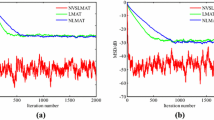Abstract
The fractional tap-length least mean square adaptive algorithm exhibits robustness and low complexity in adaptive filter design. This algorithm employs one parameter \(\gamma \), the tap-length adaptation step size, to balance convergence rate and steady-state tap-length fluctuation. From the viewpoint of threshold parameter, we justify that a time-varying \(\gamma (n)\) with large value at transient stage and small value at steady stage, instead of a fixed one, can provide both fast convergence rate and small fluctuation. Then, one time-varying strategy for \(\gamma (n)\) is suggested, where the parameter is adjusted by the difference between squared output error and squared segmented estimation error, and is limited by a sigmoid function. This strategy is motivated by the recognition that such difference indicates transient or steady state.





Similar content being viewed by others
References
R.C. Bilcu, P. Kuosmanen, K. Egiazarian, A new variable length LMS algorithm: theoretical analysis and implementations, in 9th International Conference on Electronics, Circuits and Systems, 3 (2002), pp. 1031–1034
Y. Gong, C.F.N. Cowan, A novel variable tap-length algorithm for linear adaptive filters, in IEEE International Conference on Acoustic, Speech and Signal Processing (2004), pp. 825–828
Y. Gong, C.F.N. Cowan, Structure adaptation of linear MMSE adaptive filters. IEE Proc. Vis. Image Signal Process. 151(4), 271–277 (2004)
Y. Gu, K. Tang, H. Cui, W. Du, Convergence analysis of a deficient-length LMS filter and optimal-length sequence to model exponential decay impulse response. IEEE Signal Process. Lett. 10(1), 4–7 (2003)
Y. Gu, K. Tang, H. Cui, LMS algorithm with gradient descent filter length. IEEE Signal Process. Lett. 11(3), 305–307 (2004)
M. Hamidia, A. Amrouche, Improved variable step-size NLMS adaptive filtering algorithm for acoustic echo cancellation. Digit. Signal Proc. 49, 44–55 (2016)
A. Kar, M. Chandra, Pseudo-fractional tap-length learning based applied soft computing for structure adaptation of LMS in high noise environment, in Soft Computing Techniques in Engineering Applications, ed. by S. Patnaik, B. Zhong (Springer International Publishing, Cham, 2014), pp. 115–129
A. Kar, M. Chandra, Performance evaluation of a new variable tap-length learning algorithm for automatic structure adaptation in linear adaptive filters. AEU Int. J. Electron. Commun. 69(1), 253–261 (2015)
A. Kar, R. Nath, A unique automatic and dynamic fractional order estimation for linear adaptive filters, in IEEE International Conference on Intelligent System and Data Processing (2011), pp. 264–269
L. Li, J.A. Chambers, A novel adaptive leakage factor scheme for enhancement of a variable tap-length learning algorithm, in IEEE International Conference on Acoustics, Speech and Signal Processing (2008), pp. 3837–3840
N. Li, Y. Zhang, Y. Zhao, Y. Hao, An improved variable tap-length LMS algorithm. Signal Process. 89(5), 908–912 (2009)
Z. Liu, Variable tap-length linear equaliser with variable tap-length adaptation step-size. Electron. Lett. 50(8), 587–589 (2014)
K. Mayyas, H.A. AbuSeba, A new variable length NLMS adaptive algorithm. Digit. Signal Proc. 34, 82–91 (2014)
S. Mohapatra, A. Kar, A sigmoid function based feedback filtered-X-LMS algorithm with improved offline modelling, in International Conference on Electrical Engineering/Electronics, Computer, Telecommunications and Information Technology (2015), pp. 1–5
Z. Pritzker, A. Feuer, Variable length stochastic gradient algorithm. IEEE Trans. Signal Process. 39(4), 997–1001 (1991)
F. Riera-Palou, J.M. Noras, D.G.M. Cruickshank, Linear equalisers with dynamic and automatic length selection. Electron. Lett. 37(25), 1553–1554 (2001)
J. Wang, J. Luo, Performance analysis of an improved variable tap-length LMS algorithm, in International Conference on Image Analysis and Signal Processing (2009), pp. 377–380
X. Wei, D.G.M. Cruickshank, B. Mulgrew, F. Riera-Palou, A unified approach to dynamic length algorithms for adaptive linear equalizers. IEEE Trans. Signal Process. 55(3), 908–920 (2007)
K. Wesolowski, C. Zhao, W. Rupprecht, Adaptive LMS transversal filters with controlled length. IEE Proc. F Radar Signal Process. 139(3), 233–238 (1992)
Y.K. Won, R.H. Park, J.H. Park, B.U. Lee, Variable LMS algorithms using the time constant concept. IEEE Trans. Consum. Electron. 40(3), 655–661 (1994)
D. Xu, B. Yin, W. Wang, W. Zhu, Variable tap-length LMS algorithm based on adaptive parameters for TDL structure adaption. IEEE Signal Process. Lett. 21(7), 809–813 (2014)
G. Yu, C.F.N. Cowan, An LMS style variable tap-length algorithm for structure adaptation. IEEE Trans. Signal Process. 53(7), 2400–2407 (2005)
H. Yu, Z. Liu, G. Li, A VSLMS style tap-length learning algorithm for structure adaptation, in 11th IEEE International Conference on Communication Systems (2008), pp. 503–508
Y. Zhang, J.A. Chambers, S. Sanei, P. Kendrick, T.J. Cox, A new variable tap-length LMS algorithm to model an exponential decay impulse response. IEEE Signal Process. Lett. 14(4), 263–266 (2007)
Y. Zhang, N. Li, J.A. Chambers, A.H. Sayed, Steady-state performance analysis of a variable tap-length LMS algorithm. IEEE Trans. Signal Process. 56(2), 839–845 (2008)
Author information
Authors and Affiliations
Corresponding author
Rights and permissions
About this article
Cite this article
Wei, Y., Yan, Z. Variable Tap-Length LMS Algorithm with Adaptive Step Size. Circuits Syst Signal Process 36, 2815–2827 (2017). https://doi.org/10.1007/s00034-016-0438-9
Received:
Revised:
Accepted:
Published:
Issue Date:
DOI: https://doi.org/10.1007/s00034-016-0438-9




